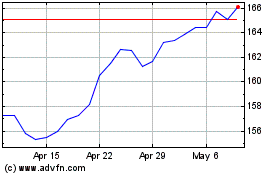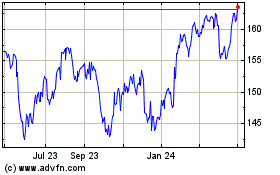P&G Adds To Streak Of Sales Increases -- WSJ
October 23 2019 - 3:02AM
Dow Jones News
By Sharon Terlep
This article is being republished as part of our daily
reproduction of WSJ.com articles that also appeared in the U.S.
print edition of The Wall Street Journal (October 23, 2019).
Procter & Gamble Co. posted another quarter of strong sales
of household staples and said it was well positioned to ride out
any pullback in consumer spending.
Helped by price increases, the maker of Tide laundry detergent
and Pampers diapers said revenue rose across all of its business
lines, including its beleaguered Gillette shaving unit. P&G is
now growing at a faster pace than competitors such as Unilever PLC
and Kimberly-Clark Corp.
The Cincinnati company said organic sales, a measure that
excludes currency moves and deals, rose 7% from a year ago.
Kimberly-Clark, maker of Huggies diapers and Kleenex tissues, on
Tuesday said organic sales rose 4%. Unilever, with brands including
Dove soap, last week reported organic sales growth of 2.9%
P&G's growth sputtered in the years following the 2008
financial crisis and only last year returned to levels seen before
the economy soured. Its turnaround has been driven by higher
prices, new products and a leaner portfolio of brands.
"We are better positioned now than in 2008 to handle a
downturn," P&G finance chief Jon Moeller said Tuesday in a call
with analysts who questioned whether the company's results would
hold up should consumers curtail spending. He said the company sees
"no signs of weakness, but that can change."
Economies have been slowing around the globe recently. Household
spending in the U.S. ticked up 0.1% on a seasonally adjusted basis
in August compared with July, lower than the average gains during
the first seven months of the year. Last week, the International
Monetary Fund cut its forecast for global economic growth this year
to 3%.
Mr. Moeller said P&G has largely stopped selling products
that tend to suffer amid consumer belt-tightening, such as makeup
and perfume. Instead, the company has focused on developing pricier
offerings in essential products such as laundry soap and
toothpaste.
Consumers' willingness to pay higher prices for household
staples, with increases driven largely by P&G as the industry's
biggest player, has fueled the company's growth. This summer,
P&G reported its strongest fiscal year since before the
recession. It was a marked reversal from the previous year, when
P&G was lagging rivals and the company was growing 1% to 2% a
quarter. Activist investor Nelson Peltz joined P&G's board the
spring of 2018 following the most expensive proxy contest in
history.
Consumer-products executives have said they expect higher
pricing to abate in coming quarters. That has already begun to
happen in some areas. Pricing accounted for 1% of P&G's sales
gains in the most recent quarter, compared with a 3% contribution
the previous quarter.
P&G is betting that shoppers will nonetheless continue to
favor higher-end variations, such as specialty toothpaste, adult
diapers made to resemble lingerie and laundry scent-beads designed
to make loads more fragrant.
If they don't, Mr. Moeller said, P&G believes it can
continue to drive sales gains by offering items packaged in smaller
quantities and with marketing aimed at budget-conscious consumers.
"If there is a downturn, we're as best positioned for consumers who
are in a pinch," he said.
P&G's net sales were $17.8 billion for the quarter ended
Sept. 30; net earnings rose to $3.6 billion, from $3.2 billion a
year earlier. The company notched its best sales gains in its
beauty segment, where organic sales increased 10% in part on higher
demand for P&G's skin care products in China, namely its
high-end SK-II brand.
Organic sales in the company's health care segment rose 9%. Mr.
Moeller said the unit was buoyed by brands acquired in last year's
$4.2 billion purchase of the consumer-health business from
Germany's Merck KGaA, which added vitamins and food supplements to
its lineup of over-the-counter medicines.
Kimberly-Clark said higher prices largely drove the company's
latest quarterly sales increase. CEO Michael Hsu said the company,
like P&G, is betting that shoppers will continue to favor
premium products, such as a line of Huggies diapers launched this
year that costs roughly 40% more than the priciest offering
previously on the market.
"Premiumization is the path a company like ours needs to take,"
Mr. Hsu said Tuesday on a call with analysts.
Both P&G and Kimberly-Clark raised their full-year
forecasts.
--Micah Maidenberg contributed to this article
Write to Sharon Terlep at sharon.terlep@wsj.com
(END) Dow Jones Newswires
October 23, 2019 02:47 ET (06:47 GMT)
Copyright (c) 2019 Dow Jones & Company, Inc.
Procter and Gamble (NYSE:PG)
Historical Stock Chart
From Mar 2024 to Apr 2024

Procter and Gamble (NYSE:PG)
Historical Stock Chart
From Apr 2023 to Apr 2024
